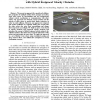Free Online Productivity Tools
i2Speak
i2Symbol
i2OCR
iTex2Img
iWeb2Print
iWeb2Shot
i2Type
iPdf2Split
iPdf2Merge
i2Bopomofo
i2Arabic
i2Style
i2Image
i2PDF
iLatex2Rtf
Sci2ools
IROS
2009
IEEE
2009
IEEE
Independent navigation of multiple mobile robots with hybrid reciprocal velocity obstacles
Abstract— We present an approach for smooth and collisionfree navigation of multiple mobile robots amongst each other. Each robot senses its surroundings and acts independently without central coordination or communication with other robots. Our approach uses both the current position and the velocity of other robots to predict their future trajectory in order to avoid collisions. Moreover, our approach is reciprocal and avoids oscillations by explicitly taking into account that the other robots also sense their surroundings and change their trajectories accordingly. We build on prior work related to velocity obstacles and reciprocal velocity obstacles and introduce the concept of hybrid reciprocal velocity obstacles for collision avoidance that takes into account the kinematics of the robots and uncertainty in sensor data. We apply our approach to a set of iRobot Create robots using centralized sensing and show natural, direct, and collision-free navigation in several challenging sc...
| Added | 24 May 2010 |
| Updated | 24 May 2010 |
| Type | Conference |
| Year | 2009 |
| Where | IROS |
| Authors | Jamie Snape, Jur P. van den Berg, Stephen J. Guy, Dinesh Manocha |
Comments (0)

